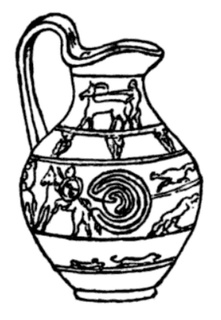 W
WRoman cavalry refers to the horse-mounted forces of the Roman army throughout the Regal, Republican, and Imperial eras.
 W
WThe Cantabrian circle was a military tactic born in the warfare in the ancient Iberian peninsula. It was employed by ancient and to a lesser extent medieval light cavalry armed with javelins or bows. As Flavius Arrianus and Hadrian relate, this was the most habitual form to appear in combat of the Cantabri tribes, and Rome adopted it after the Cantabrian Wars.
 W
WEquites cataphractarii, or simply cataphractarii, were the most heavily armoured type of Roman cavalry in the Imperial Roman army and Late Roman army. The term derives from a Greek word, κατάφρακτος kataphraktos, meaning "covered over" or "completely covered".
 W
WThe equites singulares Augusti were the cavalry arm of the Praetorian Guard during the Principate period of imperial Rome. Based in Rome, they escorted the Roman emperor whenever he left the City on a campaign or on tours of the provinces. The Equites Singulares Augusti were a highly trained unit dedicated to protecting the emperor. Men who served in the Equites Singulares Augusti held a Roman public status as an "Equites".
 W
WThe equites stablesiani were a class of cavalry in the Late Roman army. They were one of several categories of cavalry unit or vexillatio created between the 260s and 290s as part of a reorganization and expansion of Roman cavalry forces initiated during the reign of Gallienus (260-268). These new cavalry vexillationes typically shared the basic regimental designation equites, and included equites Dalmatae, equites Mauri and equites scutarii.
 W
WThe Lusus Troiae, also as Ludus Troiae and ludicrum Troiae was an equestrian event held in ancient Rome. It was among the ludi ("games"), celebrated at imperial funerals, temple foundings, or in honor of a military victory. The lusus was occasionally presented at the Saecular Games, but was not attached regularly to a particular religious festival.
 W
WThe Scholae Palatinae were an elite military guard unit, usually ascribed to the Roman Emperor Constantine the Great as a replacement for the equites singulares Augusti, the cavalry arm of the Praetorian Guard. The Scholae survived in Roman and later Byzantine service until they disappeared in the late 11th century, during the reign of Alexios I Komnenos.
 W
WThe Transvectio equitum was a parade of the young men (iuventus) of the Roman equestrian class (equites) that took place annually on 15 July. Dionysius of Halicarnassus states that the procession began at the Temple of Mars in Clivo situated along the Via Appia some two kilometers outside the Porta Capena. The procession stopped at the Temple of Castor and Pollux in the Forum Romanum before continuing on to the Temple of Iuppiter Optimus Maximus on the Capitoline Hill. The religious rite traced its origins to the battle of Lake Regillus when the Dioscuri gave aid to the Romans during the battle itself.